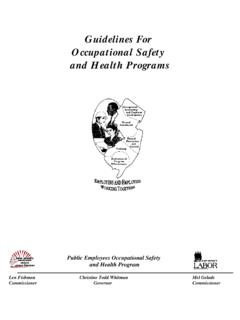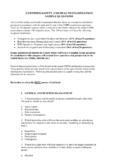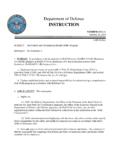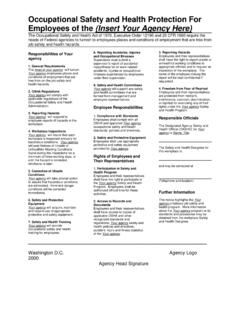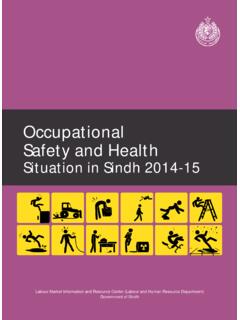Transcription of American National Standard for Occupational …
1 Department of the Interior bureau of reclamation December 2015 Final Draft Report American National Standard for Occupational health and safety Management Systems (ANSI Z10) safety and Occupational health Program Action Plan Team #2 Recommendations Mission Statements The mission of the Department of the Interior is to protect and provide access to our Nation s natural and cultural heritage and honor our trust responsibilities to Indian Tribes and our commitments to island communities. The mission of the bureau of reclamation is to manage, develop, and protect water and related resources in an environmentally and economically sound manner in the interest of the American public. American National Standard for Occupational health and safety Management Systems (ANSI Z10) Prepared by: safety and Occupational health Program Action Plan Team #2 Mike Bernardo, Lower Colorado Regional Office Trina Mailloux, Great Plains Regional Office Brenda Mendoza, Albuquerque Area Office David Palumbo, Lower Colorado Regional Office Juli Smith, Lower Colorado Regional Office Toni Turner, Snake River Area Office Amy Whittington, Great Plains Regional Office i Contents Page Executive Summary.
2 1 Background .. 3 Overview of ANSI 6 reclamation Policy and ANSI Z10 Comparison Results .. 8 Comparison Conclusions .. 9 Implementation Perception Survey .. 10 Survey Conclusions .. 10 Program Strengths .. 10 Program Weaknesses .. 11 Recommendations .. 12 Conclusion .. 13 References .. 14 Appendices Appendix A: Survey Analysis and Short-Term Recommendations Appendix B: Conformance Scorecard ANSI Z10 Elements Compared with reclamation SAF Products Appendix C: Survey Questions Appendix D : Survey Response Breakdown by Position Appendix E: Survey-Identified Strengths and Weaknesses Appendix F: SAF P01: reclamation safety and Occupational health Program Appendix G: SAF 01-01: reclamation Occupational safety and health General Appendix H: ANSI Z10 Occupational health and Management Systems Requirements ii Acronyms ANSI Z10 or Z10 American National Standard for Occupational health and safety Management Systems D&S Directives & standards DOI Department of the Interior JHA Job Hazard Analysis MESH Managing Employee safety & health (Training) OHSMS Occupational health and safety Management System RLT reclamation Leadership Team RSHS reclamation safety & health standards SOH safety & Occupational health 1 Executive Summary In 2012, the Department of the Interior s Office of Occupational safety and health (DOI) conducted a review of the entire reclamation safety and Occupational health (SOH) Program and identified areas needing improvement.
3 Two of the review s conclusions (identified in a report published in July 2013) refer to (1) the lack of accountability systems to ensure the effective implementation of the safety and Occupational health Program and (2) the incomplete implementation of the safety policy as the cause for reclamation not establishing safety as a core value. Additionally, the lack of an implementation plan was identified in multiple conclusions within the DOI report. Program Action Plan Teams were established in 2014 to address the deficiencies noted in the review. Team #2 was tasked to evaluate the agency s implementation of reclamation safety policy SAF P01 ( dated July 23, 2013) which states that reclamation will implement the principles of American National Standard for Occupational health and safety Management Systems (ANSI Z10 or Z10) Plan, Do, Check, Act . The objective of this report is to provide recommendations to address gaps in existing reclamation policies, directives and standards (D&Ss), and implementation actions, and more fully integrate the ANSI Z10 principles into reclamation s safety culture.
4 The Team recommends the reclamation Leadership Team (RLT) take the following actions to achieve this goal (more details can be found in the Recommendations section of this report): 1. Expand and clarify reclamation s safety Policy, SAF P01. 2. Re-write / clarify reclamation s policy implementation instruction, SAF 01-01, with references to new supplemental directives. 3. Develop supplemental D&Ss to address the gaps with ANSI Z10 principles regarding employee participation, planning, implementation, evaluation, and management review. 4. Streamline implementation efforts within existing processes and internal controls where practical. 5. In the short term, begin implementing the recommendations provided to resolve the gaps identified in the perception survey (Appendix A) and improve communications to clarify expectations. 2 The Team concludes that developing a system of directives that align reclamation policies and standards with ANSI Z10 would provide the foundation for more successful SOH program implementation.
5 Additionally, implementation of the ANSI Z10 management system will enable continual, measureable, and sustainable improvement. 3 Background The Department of Interior s Office of Occupational safety and health reviewed reclamation s safety and Occupational health Program in 2012. Two of the report s conclusions (1-2 and 6-1, seen below) have general and specific references, respectively, to the implementation of reclamation s SOH policy SAF P01. Conclusion 1-2 identifies the need to establish safety as a core value, while Conclusion 6-1 states that SAF P01, and in particular, its reference to adopting American National Standard for Occupational health and safety Management Systems (ANSI Z10 or Z10), has the potential to establish the foundation for a strong safety culture within reclamation . Table 1: DOI SOH Report Conclusions Addressed by Team #2 Conclusion 1-2 Conclusion 6-1 Senior leadership and line management have not established safety as an organizational value throughout all ranks of reclamation and have not established accountability systems to ensure effective implementation of the safety and Occupational health program at the working level.
6 A degree of cultural complacency exists in reclamation that results in the acceptance of workplace hazards and contributes to the presence of uncorrected hazards, non-compliance issues, and incomplete SOH program implementation.. The newly adopted safety and health policy (SAF P01) could serve as a foundation to address this weakness, but an implementation plan has yet to be developed. reclamation has recently approved reclamation Manual Policy SAF P01, safety and Occupational health Program that establishes the foundation for an effective SOH Program. This policy defines responsibilities and also requires SOH managers to organizationally report to senior leadership or management of their respective offices which is potentially of great benefit to the safety program. Very importantly it adopts ANSI Z10 principles for an SOH management system and accordingly emphasizes continuous improvement processes and developing and implementing SOH as a core value of reclamation .
7 This policy establishes the foundation to build a strong safety culture .. reclamation has not established a concrete action and implementation plan with expectations, action items, and timetables to achieve the worthwhile objectives of this policy; however this will be addressed beginning with its FY 2014 Action Plan. In 2014, 21 reclamation Action Teams were formed to address the various weaknesses in the SOH Program that were identified in the DOI report. SOH Action Team #2 was tasked with identifying gaps in the implementation of SAF P01 and ANSI Z10. SAF P01 provides direction 4 for the implementation of reclamation s SOH Program as required by DOI and Executive Orders, and is designed to incorporate the principles and best practices identified in Z10. Although SAF P01 was finalized in 2013, it was not clear how well the policy had been implemented across reclamation .
8 Z10, a National consensus Standard , employs the fundamental process of continuous improvement in meeting and exceeding SOH standards to help ensure employers provide a safe and healthful workplace. Z10 is valuable to the entire safety action process and at least 16 of the 21 reclamation safety Action Teams are addressing Z10 principles in their efforts. The Team approached the task by reviewing reclamation s existing SAF documents to evaluate if the ANSI Z10 principles are fully addressed in the policy and directives. The implementation of the SAF policy and ANSI principles was then assessed by conducting a survey of reclamation management staff and safety professionals. Lastly, gaps in reclamation s implementation of SOH policies and D&Ss were characterized. Recommendations were developed to resolve both the policy and implementation gaps. reclamation has one policy, six D&Ss and a handbook of standards for the agency s SOH Program.
9 Of these, SAF P01 establishes the policy, SAF 01-01 provides general program implementation guidance, and the reclamation safety and health standards (RSHS) provide the minimum required criteria for reclamation workers and contractors. The remaining five documents provide guidance on specific topics under the umbrella of the SOH Program: these include accident reporting and investigation (SAF 01-02), motor vehicle safety (SAF 01-04), diving (SAF 01-05), inspection and abatement (SAF 01-06), and exposure assessment (SAF 02-01). Upon reviewing these D&Ss, the Team determined its focus should be on the program policy and implementation directive. Team #2 s review of these documents found that the ANSI Z10 principles are not fully addressed in reclamation policy and directives, and that additional implementation guidance is required. A consolidated implementation plan that more closely aligns SAF 01-01 with Z10 would significantly improve the program and allow for more measureable progress, consistent annual goal prioritization, and programmed periodic reviews.
10 A Google survey consisting of 28 questions was sent to management and safety professionals throughout the agency to assess gaps in the knowledge of and implementation of SAF P01 and ANSI Z10 principles. With a response rate of approximately 71%, the prevailing perception is that reclamation maintains the workplace and equipment in a safe manner, and continual improvement of SOH program performance is occurring. However, understanding the roles and responsibilities of SOH personnel and their ability to effectively accomplish their work was seen 5 as a program weakness. Using these responses, Team #2 identified and prioritized the specific areas needing improvement, and made recommendations to address the gaps. Disparities seen in the survey results, such as those related to roles, responsibilities and processes involving safety support and employee participation appear to correlate with the lack of specific direction in the D&S.










